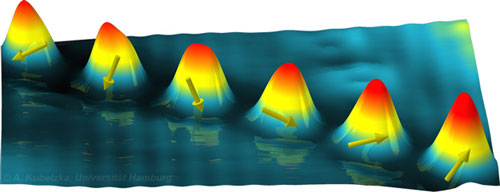| Posted: May 6, 2010 |
Depiction and manipulation the spin direction of individual atoms |
|
(Nanowerk News) An international team of researchers has built a chain of cobalt atoms and analysed its magnetic properties ("Imaging and manipulating the spin direction of individual atoms"). Surprisingly, the spin sensitive measurements (”Spins“ = magnetic moments of electrons) show that the observed form of atoms depends on its magnetic orientation.
|
|
Although it is one of the oldest physical phenomena, magnetism is a current international research field. New measurements enable an insight in the fundamental interactions that determine the characteristics of magnetic structures. The aim of the research is to facilitate hard drives with a higher storage density.
|
 |
| Lateral manipulation of a chain of six cobalt atoms.
|
|
The digital alphabet consists of only two signs: “0“ and “1“ which corresponds well with the magnetic coding ”North Pole” and ”South Pole”. The smallest data units (“bits") can be imagined as tiny compass-needles that can take the value ”1” or ”0”, depending on whether the direction of magnetisation is North or South.
|
|
The ultimate goal is saving a bit as direction of magnetisation of a single atom. This miniaturisation causes two problems:
|
|
i. The energetic barrier between “0“ and “1“ decreases with the structural size so that thermal fluctuations can result in a data loss.
|
|
ii. The magnetic properties of atomic structures are hardly predictable.
|
|
For the experiment, cobalt atoms were applied to a manganese surface. The manganese atoms arrange themselves magnetically in a spiral pattern.
|
|
This surface was chosen for two reasons:
|
|
i. Thermal fluctuations are prevented by exchange coupling.
|
|
ii. The surface sets the spin direction which enables a systematic examination.
|
|
Spin-polarised scanning tunnelling microscopy (SP-STM) was used as measurement. Thereby, a magnetic tip scans a surface within a distance of some tenth of nanometres. The measured tunnel current depicts the electron density and the local spin direction with extremely high local resolution.
|
|
Indeed, not only the measured height of the cobalt atoms but also their shape depends on the spin direction. Parameter-free electron structure calculations show that spin-dependent orbital symmetries of the cobalt electrons are responsible for this phenomenon.
|
|
The result is that a specific shape can be assigned to each spin direction so that more than only one bit can be read per atom. By using atomic manipulation, cobalt atoms can now be placed at any position on a surface whre they align parallel with the next atom. Thus, the spin direction of individual atoms can now be selectively adjusted.This very first combination of spin sensitivity and atomic manipulation opens up new opportunities in the production and analysis of magnetic structures.
|

